全国首届小学英语优质课竞赛一等奖教案
优质小学英语教案分享:全国首届小学英语优质课竞赛一等奖教案(一)

优质小学英语教案分享:全国首届小学英语优质课竞赛一等奖教案(一))作为小学英语老师,我们一直在探索如何更好地教授英语,如何让孩子在课堂上更有效地学习英语,提高英语能力。
在这个过程中,我很幸运地发现并使用了一份全国首届小学英语优质课竞赛一等奖教案(一),今天我将和大家分享这份优质教案。
一、教学目标1.了解常见的水果名称,学习描述水果的颜色、形状和口感的形容词;2.提高对于名词单复数和第三人称变化的运用能力;3.能够参与水果问答、听力和口语表述等活动,提高英语听说能力。
二、教重点1.掌握常见水果的英语名称;2.运用形容词描述水果的颜色、形状和口感;3.了解名词的单复数和第三人称变化规则。
三、教学难点1.针对名词单复数的变化规则进行准确运用;2.运用形容词描述水果的特征,提高描述的准确性。
四、教学内容1.课堂导入老师会播放一段关于水果的视频,并询问孩子们是否喜欢吃水果。
通过谈论关于水果的话题进行导入,引起孩子们对这节课的兴趣。
2.听力训练老师会播放一段讲解水果名称和形状的录音,并要求孩子们跟随录音口胡。
老师会分发一份水果表格,要求孩子们听录音,尝试填写表格中空缺的部分。
这样的听力训练可以提高孩子们的听力理解和词汇记忆能力,帮助孩子们更好地掌握水果名称。
3.语言表达老师会呈现一个水果篮子,并让孩子们围绕篮子进行提问和回答。
如“Do you like apples?”“Yes, I do.”或是“ What color is the pear?”“Green.”这样的互动可以提高孩子们的口语表达能力和对话技巧。
4.单词巩固老师会出示一些卡片,上面写有水果名称和形状,要求孩子们进行连线,巩固所学的单词姓名与形状的对应关系。
同时,老师会通过展示一个水果,并口头介绍这个水果的颜色、形状和口感,让孩子们逐渐掌握形容词描述该水果的能力。
例如,“This is a round red apple. It is sweet and juicy.”5.语法练习讲解名词的单复数及第三人称变化规则,例如“apples”和“pears”是名词的复数形式,“She likes apples”中的“likes”是动词的第三人称形式。
全国首届小学英语优质课竞赛一等奖教案
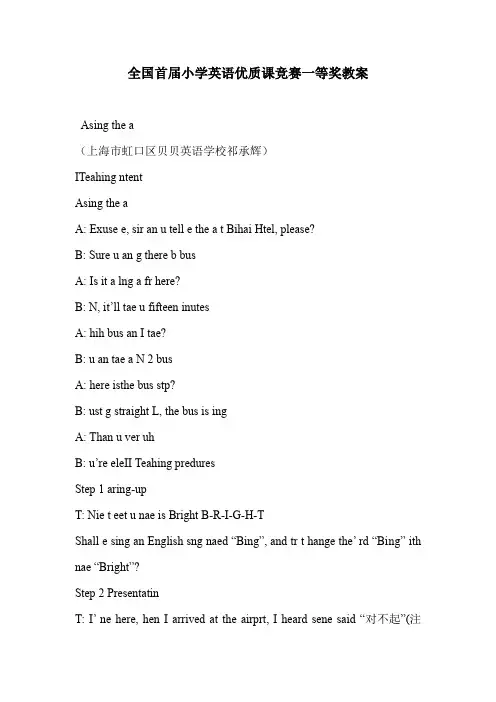
全国首届小学英语优质课竞赛一等奖教案Asing the a(上海市虹口区贝贝英语学校祁承辉)ITeahing ntentAsing the aA: Exuse e, sir an u tell e the a t Bihai Htel, please?B: Sure u an g there b busA: Is it a lng a fr here?B: N, it’ll tae u fifteen inutesA: hih bus an I tae?B: u an tae a N 2 busA: here isthe bus stp?B: ust g straight L, the bus is ingA: Than u ver uhB: u’re eleII Teahing preduresStep 1 aring-upT: Nie t eet u nae is Bright B-R-I-G-H-TShall e sing an English sng naed “Bing”, and tr t hange the’ rd “Bing” ith nae “Bright”?Step 2 PresentatinT: I’ ne here, hen I arrived at the airprt, I heard sene said “对不起”(注①),”早晨好”(注②)I reall ant t n their eanings in English uld u help e? S: “对不起” is “Exuse e” and “早晨好” is “Gd rning”T: Thans a lt And n uld u tell e sething abut ur it? I ant t travel in this it, but I dn’t n here I shuld gS1: Bai Lian Dng ParS2: Fisher GirlS3: iuzhu TnT: Gd But I ant t find a htel nPlease d e a favur an u tell e the naes f se htels in this it?S1: 2000 HtelS2: indu HtelS3: Bihai Htel(The teaher taes ntes hile the students are speaing)Step 3 Ne strutures learningT: The all sund ver nie But h an I get there, b bus r b bie?S: B busT: And h lng ill it tae e t get there? abefifteen inutes is enugh(The teaher ls at the ath and gives the students a gesture)1) Dra a sti-figure piture t help the students understand the eaning f the sentene:“It’ll tae sene se tie t d sething”2) rite the sentene “It’ll tae u fifteen inutes “ n the blabard, and have the students iitate the sentene3) A guessing gae:T: Please l at these pitures and guess “H lng ill it tae e t ?”T: H lng ill it tae e t have a ftball ath?S1: It’ll tae u ninet inutesT: es4) Get the students t listen t the rerding f the dialgue, in rder t intrdue the ne sentene: “ust g straight”) Use the ulti-edia t help the students understand the eaning f the sentene “G straight”6) rite the sentene n the blabard, and have the students iitate the sentene: “ust g straight”Step 4 Pratie1) As the students t listen t the dialgue ne re, then as the t repeat after the tape, first individuall and then in pairs2) Enurage the students t read their dialgue ith their desatesStep nslidatinT: u n I’ fr Shanghai abe in the future u’ll g t Shanghai, s I’ve prepared se phtgraphs fr u1) Sh the phtgraphs f “Naning Rad”, “Pudng Ne Area” and “the Bund” t the students2) Get the students t as the teahers fr Shanghai sething the dn’t n, suh as diretins, transprtatins in Shanghai3) As se students t intrdue their tur plans t Shanghai注①、注②:因竞赛在珠海举行,授教师用广东话说“对不起”和“早晨好”。
【免费下载】全国首届小学英语优质课竞赛一等奖教案
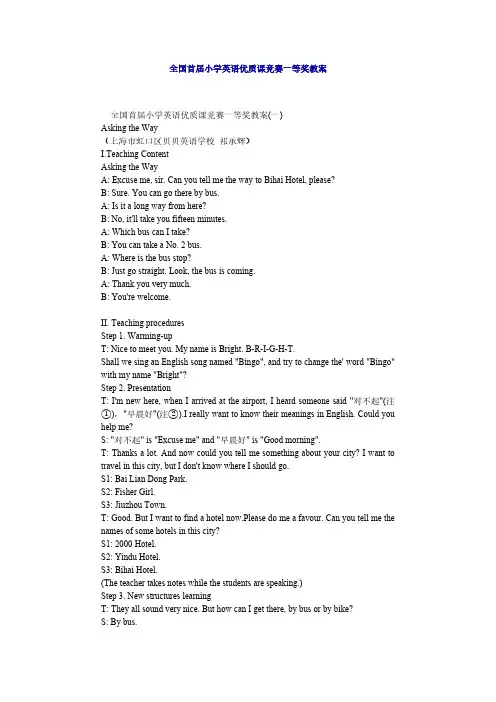
全国首届小学英语优质课竞赛一等奖教案全国首届小学英语优质课竞赛一等奖教案(一)Asking the Way(上海市虹口区贝贝英语学校祁承辉)I.Teaching ContentAsking the WayA: Excuse me, sir. Can you tell me the way to Bihai Hotel, please?B: Sure. You can go there by bus.A: Is it a long way from here?B: No, it'll take you fifteen minutes.A: Which bus can I take?B: You can take a No. 2 bus.A: Where is the bus stop?B: Just go straight. Look, the bus is coming.A: Thank you very much.B: You're welcome.II. Teaching proceduresStep 1. Warming-upT: Nice to meet you. My name is Bright. B-R-I-G-H-T.Shall we sing an English song named "Bingo", and try to change the' word "Bingo" with my name "Bright"?Step 2. PresentationT: I'm new here, when I arrived at the airport, I heard someone said "对不起"(注①),"早晨好"(注②).I really want to know their meanings in English. Could you help me?S: "对不起" is "Excuse me" and "早晨好" is "Good morning".T: Thanks a lot. And now could you tell me something about your city? I want to travel in this city, but I don't know where I should go.S1: Bai Lian Dong Park.S2: Fisher Girl.S3: Jiuzhou Town.T: Good. But I want to find a hotel now.Please do me a favour. Can you tell me the names of some hotels in this city?S1: 2000 Hotel.S2: Yindu Hotel.S3: Bihai Hotel.(The teacher takes notes while the students are speaking.)Step 3. New structures learningT: They all sound very nice. But how can I get there, by bus or by bike?S: By bus.T: And how long will it take me to get there? Maybefifteen minutes is enough.(The teacher looks at the watch and gives the students a gesture.)1) Draw a stick-figure picture to help the students understand the meaning of the sentence:"It'll take someone some time to do something."2) Write the sentence "It'll take you fifteen minutes. " on the blackboard, and have the students imitate the sentence.3) A guessing game:T: Please look at these pictures and guess "How long will it take me to ...?"T: How long will it take me to have a football match?S1: It'll take you ninety minutes.T: Yes.4) Get the students to listen to the recording of the dialogue, in order to introduce the new sentence: "Just go straight."5) Use the multi-media to help the students understand the meaning of the sentence "Go straight."6) Write the sentence on the blackboard, and have the students imitate the sentence: "Just go straight."Step 4. Practice1) Ask the students to listen to the dialogue once more, then ask them to repeat after the tape, first individually and then in pairs.2) Encourage the students to read their dialogue with their deskmates.Step 5. ConsolidationT: You know I'm from Shanghai. Maybe in the future you'll go to Shanghai, so I've prepared some photographs for you.1) Show the photographs of "Nanjing Road", "Pudong New Area" and "the Bund" to the students.2) Get the students to ask the teachers from Shanghai something they don't know, such as directions, transportations in Shanghai.3) Ask some students to introduce their tour plans to Shanghai.注①、注②:因竞赛在珠海举行,授课教师用广东话说“对不起”和“早晨好”。
全国首届小学英语优质课竞赛一等奖教案
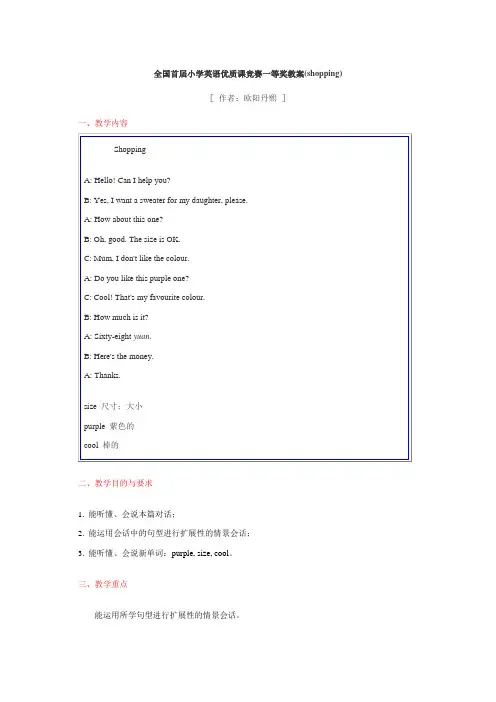
全国首届小学英语优质课竞赛一等奖教案(shopping)[作者:欧阳丹熙]一、教学内容二、教学目的与要求1. 能听懂、会说本篇对话;2. 能运用会话中的句型进行扩展性的情景会话;3. 能听懂、会说新单词:purple, size, cool。
三、教学重点能运用所学句型进行扩展性的情景会话。
四、教学手段运用多媒体辅助教学。
五、教具准备一件毛衣,各种文具、食品、服装、玩具和水果等。
六、教学步骤Step 1. GreetingsT: Good morning, boys and girls. glad to meet you.Step 2. Presentation(1) Lead-inT: You know, I'm new here. I thought it would be hot in Zhuha.But today it is cold. I'm just in a blouse.Now I'm feeling a little cold. So I want to go shopping and buy some warm clothes. (Read the title "shiopping".)(2) Play a guessing game (课件:显示屏上出现一些碎片,碎片慢慢扩大,变成一件毛衣)T: What am I going to buy? What do I want? Just guess and say: "YOu want ..."(3)(课件:教师走进一家服装店,与售票员进行交谈。
)T= the teacher C= the computer Ss= the students(4) Play a game: Guess the price of the sweater.Ss: How much is it?S1 : ...yuan.(If the price S1 guess is too low, the teacher will say:"Up, up, up."; if too high, the teacher will say:'' Down, down,down." Each students has three chances to guess.)After the students guess the price right, the teacher puts on the purple sweater and asks the students "Am I cool?"(Leatn to say:"Cool".)Step 3. Practice(1)Listen to the dialogue.T: What have you heard in the dialogue?(2)Listen to the dialogue and repeat it sentence by sentence.(3)Pratice in groups of three.Step 4 Consolidation(1)Divide all the students into 5 groups: stationer's, toy shop, clothes shop, fruit shop and food shop. Put some goods in eachshop. Get the students to do the shopping in groups. (每组由一名学生当售货员,其它学生充当顾客。
全国首届小学英语优质课竞赛一等奖教案
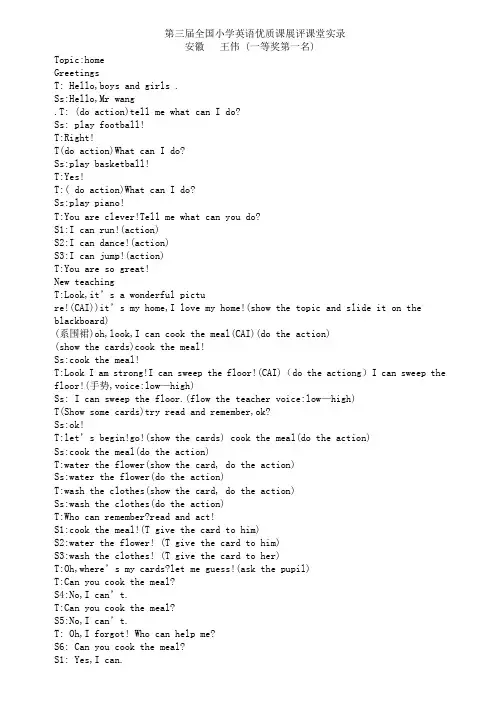
第三届全国小学英语优质课展评课堂实录安徽王伟 (一等奖第一名)Topic:homeGreetingsT: Hello,boys and girls .Ss:Hello,Mr wang.T: (do action)tell me what can I do?Ss: play football!T:Right!T(do action)What can I do?Ss:play basketball!T:Yes!T:( do action)What can I do?Ss:play piano!T:You are clever!Tell me what can you do?S1:I can run!(action)S2:I can dance!(action)S3:I can jump!(action)T:You are so great!New teachingT:Look,it’s a wonderful picture!(CAI))it’s my home,I love my home!(show the topic and slide it on t he blackboard)(系围裙)oh,look,I can cook the meal(CAI)(do the action)(show the cards)cook the meal!Ss:cook the meal!T:Look I am strong!I can sweep the floor!(CAI)(do the actiong)I can sweep the floor!(手势,voice:low—high)Ss: I can sweep the floor.(flow the teacher voice:low—high)T(Show some cards)try read and remember,ok?Ss:ok!T:let’s begin!go!(show the cards) cook the meal(do the action)Ss:cook the meal(do the action)T:water the flower(show the card, do the action)Ss:water the flower(do the action)T:wash the clothes(show the card, do the action)Ss:wash the clothes(do the action)T:Who can remember?read and act!S1:cook the meal!(T give the card to him)S2:water the flower! (T give the card to him)S3:wash the clothes! (T give the card to her)T:Oh,where’s my cards?let me guess!(ask the pupil)T:Can you cook the meal?S4:No,I can’t.T:Can you cook the meal?S5:No,I can’t.T: Oh,I forgot! Who can help me?S7:Can you sweep the floor?S8:No,I can’t.S7:Can you sweep the floor?S2:Yes,I can.S9:Can you wash the clothes?S3:Yes,I can.T:You are so cool!look ,let’s go!(手势,voice low—high)Can you wash the clothes?Ss: Can you wash the clothes?(flow the teacher, 手势,voice low—high)T:who can do it ?(手势) come to front!S10: let’s go!(手势,voice low—high)Can you wash the clothes?Ss: Can you wash the clothes?(flow the teacher, 手势,voice low—high)T:wonderful!You should say:yes!S10:Yes!(do the actin)T:Who else?S11: let’s go!(手势,voice low—high)Can you wash the clothes?Ss: Can you wash the clothes?(flow the teacher, 手势,voice low—high)S11:Yes!T:You have done a good job!Now,I will give a paper to you,listen to the tape ,then answer the question on it,ready?Ss:Yes!T;Go!(tape) Amy:Hello,Sam! Sam:Hello!A:Can you water the flower? S:Yes,I can.A:Can you cook the meal? S:No.I can’t.A:What do your parents do at home?Can your father cook themeal? S:No,he can’t.A:Can your mother cook the meal? S:Of course!Sometimes,my parents wash the clothes,?together.T:Ok,change your ideas by yourgroup.Then answer the question.>T:let’s look the question,together.Can Sam water the flower?Ss:No,he can’t.T:Can Sam cook the meal?Ss:No,he can’t.T:Who can cook the meal?Ss:Sam’s mother can cook the meal.T:You are so clever!Now let’s play a game! Who can come to front?(let the pupil come to the front,give a card tohim,then let him act.)S12:(Do the action)guess!S13:Can you dance?S12:No,I can’t.S14:Can you water the flower?S12:Yes,I can.S14:Yes!(practice play football,brush teath,cook the meal,play basketball in the same way)T:Who can do house work in your home?S15:my motherS16: my motherS17:my fatherS18:me!T:good we should do house work together,let’s make a house work plan,here’s the plan,finsh it by your groupWhat can you do?What can your father do?What can your mother do?Ss:Ask and answer in the group finsh the house work planT:let’s look the house plan of S16’s,let’s ask !Ss: What can you do?S16:I can sweep the floor.Ss: What can your father do?S16:He can wash the clothes.Ss: What can your mother do?S16:She can cook the meal.T:Good plan ,a happy family!let’s look and sing,do the actins together,ok?(CAI) Ss(look and sing do the action)Can you run?Yes,I can.Can you sing? Yes,I can.Can you dance?No,I can’t.T:Ok,are you happy today?Ss:Yes.T:let’s say yes(do action)Ss:Yes!(do action)上海吴绯霞课题: Travel授课过程:(A) Warmer up:(The pupils come to the seat.)T: Hello, where are you from?Ss: I’m from xx Primary School.T: Welcome.(Show a cartoon picture of the teacher on the screen.)T: Can you guess who’s she?Ss: Cindia.T: Yes, it’s m e.(The pupils come to the seat and sit well.)(B)New Teaching.(Teacher plays the music of Beijing Opera.)T: Beijing is a beautiful city. We’ll go to Beijing tomorrow. What will we watch? Ss: We’ll watch Beijing Opera.T: What will we eat?Ss: We’ll eat rock duck.T: Tomorrow it’ll be Wednesday. We’ll go to Xiangshan on Wednesday.What will we do on Thursday?S1: We’ll go to Tian’an men.T: What will you do on Friday?S2: We’ll go to the Great Wall.T: Saturday?S3: We’ll go to the Summer Palace.T: We’ll watch Beijing Opera on Sunday.T say a chant: We’ll go to Beijing. We’ll eat there. We’ll go to the Summer Palace. We’ll have good time there.Ss say the chant again.T: Beijing is a good place. (Then teacher show a VCD: Succession of Beijing’s application for Olympic Games.)(Teacher shows a fan and act as a beautiful girl in Suzhou.)T: Where am I from?Ss: Suzhou.T: Where have you visited in Suzhou? Can you say something?S1: LiuYuan.S2: Shi Zilin.S3: Han Shansi.T: You have some pictures on your desk. You can say where you will go.(The pupils say the sentences in the groups.)T: Where will you go?S1: I’ll go to Liu Yuan.T: What will you see?S1: I’ll see many flowers.T: There are many beautiful places in Suzhou. Have you got friends in other city? Ss: Yes.(Teacher shows a postcard.)T: Look at the postcard. On the postcard what can we write?S1: We are in Suzhou.(Teacher writes the sentence on the card.)T: Suzhou is a beautiful city. There are lots of trees. I love this city. (Ss write the postcards in groups and teacher plays the tape of the music.) Then each group give a report.(Teacher shows a picture of Hanshan Temple.)T: What’s this?Ss: Hanshan Temple.T: I love the place. Do you know why? (Play the tape of music)T: Do you want to Hanshan Temple? Look at the map of Suzhou. Hanshan Temple is here. (Show the map of Suzhou and Hanshan Temple.)T: How can we go there? Walk there? By foot? No.S1: We’llS2: We’ll go there by bike.T: And?S3: We’ll go there by motorcycle.S4: We’ll go the re by car.T: Look, this is a plan for visiting Suzhou. Let’s finish this form together. (Show a big form on the blackboard.)A Plan For Visiting Suzhouwherewhenhowphotos card(Teacher and the pupils finish the form together. And the pupils come to the front and stick the photos and cards in the form. Then pupils give a report.)T: Welcome to Suzhou四川何霞课题:FestivalsⅠ.Warming up:T: Good morning, boys and girls.Ss: Good morning, teacher.Ⅱ.New Teaching:T: What do you know about some festivals?S1: Children’s Day.T: Good.S2: Teacher’s Day.T: Wonderful.T: What is the most important festivals in China?S3: Spring Festival.T: What is the most important festivals in USA?S3: Christmas.T: Let’s say something about Christmas.S4: Snow.S5: Tree.S6: Presents.S7: Food.(板书)T: I have a student. His English is poor. His name is Jason. Now there is a letter. Let’s read it and help him.(教师领读,学生跟读。
小学英语教学精品之一:全国首届小学英语优质课竞赛一等奖教案(一)
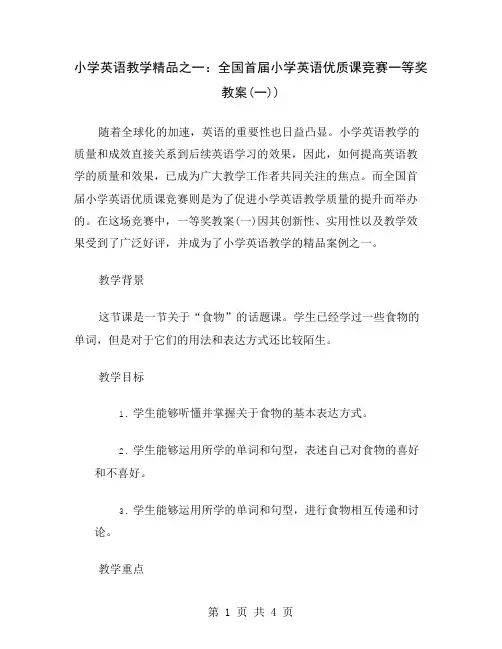
小学英语教学精品之一:全国首届小学英语优质课竞赛一等奖教案(一))随着全球化的加速,英语的重要性也日益凸显。
小学英语教学的质量和成效直接关系到后续英语学习的效果,因此,如何提高英语教学的质量和效果,已成为广大教学工作者共同关注的焦点。
而全国首届小学英语优质课竞赛则是为了促进小学英语教学质量的提升而举办的。
在这场竞赛中,一等奖教案(一)因其创新性、实用性以及教学效果受到了广泛好评,并成为了小学英语教学的精品案例之一。
教学背景这节课是一节关于“食物”的话题课。
学生已经学过一些食物的单词,但是对于它们的用法和表达方式还比较陌生。
教学目标1.学生能够听懂并掌握关于食物的基本表达方式。
2.学生能够运用所学的单词和句型,表述自己对食物的喜好和不喜好。
3.学生能够运用所学的单词和句型,进行食物相互传递和讨论。
教学重点1.掌握“Do you like…”和“It’s…”的用法。
2.学会表述自己对食物的喜好和不喜好。
3.学会使用个体主义和集体主义的表达方式。
教学难点如何使学生在实际的交际中运用所学的语言知识。
教学过程一、情境导入教师播放一些食物的图片,询问学生对它们的了解程度,并引导学生回忆所学过的食物单词。
二、语言引入教师通过PPT展示一张“Do you like…”的图片,引导学生掌握这个常用的句型。
随后,教师展示另一张包含各种食物的图片,用这两个句型引导学生表述自己对不同食物的喜欢程度。
三、语言运用1.个体主义表达方法:教师将学生分组,每组讨论自己最喜欢的食物,并用“Do you like…”和“It’s…”的句型表达自己的观点。
随后,教师将不同组的学生叫到前面,就他们各自最喜欢的食物进行讨论。
2.集体主义表达方法:教师告诉学生,今天中午,班级将一起去食堂吃饭,但是我们应该如何订餐呢?教师提供几种选择,要求学生借助页面上提供的句型以及所学的单词和句型进行讨论,并提出他们自己的建议和意见。
教师将学生的讨论结果行汇总,使得学生理解到集体主义的表达方法。
全国首届小学英语优质课竞赛一等奖教案新部编本
教师学科教案[ 20 – 20 学年度第__学期]任教学科:_____________任教年级:_____________任教老师:_____________xx市实验学校全国首届小学英语优质课竞赛一等奖教案Asking the Way上海市虹口区贝贝英语学校祁承辉I. Teaching ContentAsking the WayA: Excuse me, sir. Can you tell me the way to Bihai Hotel, please?B: Sure. You can go there by bus.A: Is it a long way from here?B: No, it'll take you fifteen minutes.A: Which bus can I take?B: You can take a No. 2 bus.A: Where is the bus stop?B: Just go straight. Look, the bus is coming.A: Thank you very much.B: You're welcome.II. Teaching proceduresStep 1. Warming-upT: Nice to meet you. My name is Bright. B-R-I-G-H-T.Shall we sing an English song named "Bingo", and try to change the' word "Bingo" with my name "Bright"?Step 2. PresentationT: I'm new here, when I arrived at the airport, I heard someone said "对不起"(注①),"早晨好"(注②).I really want to know their meanings in English. Could you help me?S: "对不起" is "Excuse me" and "早晨好" is "Good morning". T: Thanks a lot. And now could you tell me something about your city? I want to travel in this city, but I don't know where I should go.S1: Bai Lian Dong Park.S2: Fisher Girl.S3: Jiuzhou Town.T: Good. But I want to find a hotel now.Please do me a favour. Can you tell me the names of some hotels in this city?S1: 2000 Hotel.S2: Yindu Hotel.S3: Bihai Hotel.(The teacher takes notes while the students are speaking.)Step 3. New structures learningT: They all sound very nice. But how can I get there, by bus or by bike?S: By bus.T: And how long will it take me to get there? Maybefifteen minutes is enough.(The teacher looks at the watch and gives the students a gesture.)1) Draw a stick-figure picture to help the students understand the meaning of the sentence:"It'll take someone some time to do something."2) Write the sentence "It'll take you fifteen minutes. " on the blackboard, and have the students imitate the sentence.3) A guessing game:T: Please look at these pictures and guess "How long will it take me to ...?"T: How long will it take me to have a football match?S1: It'll take you ninety minutes.T: Yes.4) Get the students to listen to the recording of the dialogue, inorder to introduce the new sentence: "Just go straight."5) Use the multi-media to help the students understand the meaning of the sentence "Go straight."6) Write the sentence on the blackboard, and have the students imitate the sentence: "Just go straight."Step 4. Practice1) Ask the students to listen to the dialogue once more, then ask them to repeat after the tape, first individually and then in pairs.2) Encourage the students to read their dialogue with their deskmates.Step 5. ConsolidationT: You know I'm from Shanghai. Maybe in the future you'll go to Shanghai, so I've prepared some photographs for you.1) Show the photographs of "Nanjing Road", "Pudong New Area" and "the Bund" to the students.2) Get the students to ask the teachers from Shanghai something they don't know, such as directions, transportations in Shanghai.3) Ask some students to introduce their tour plans to Shanghai.注①、注②:因竞赛在珠海举行,授课教师用广东话说“对不起”和“早晨好”。
小学教师必备:全国首届小学英语优质课竞赛一等奖教案(一)精讲
小学教师必备:全国首届小学英语优质课竞赛一等奖教案(一)精讲。
全国首届小学英语优质课竞赛一等奖教案(一)以“Let's go shopping”为主题,将英语课与实际生活场景相结合,充分利用学生的生活经验和兴趣爱好,开展了一堂生动活泼的英语课。
这节课的教学目标是为学生提供一个购物的场景,让学生学会描述物品的形状、颜色、大小等,以及站在不同的角度与店员交流的能力。
教案分为四个部分:一、导入:通过引入老师或学生购物的真实经验,引起学生对购物的兴趣。
在导入中,老师通过图片、视频等多种方式,让学生感受到了购物生活中丰富多彩的场景,使学生产生了亲近和好奇。
二、展示:老师通过图片或视频展示各种购物场景,同时让学生模仿和描述不同的物品,掌握物品描述的技巧和词汇。
三、练习:在学生真正理解了物品描述的技巧和词汇后,老师分别设置了两个环节,首先是学生在角色扮演中训练语音和交流交流能力,然后是让学生进行实际购物的任务,提高学生的实践能力,让学生在实践中深入理解和掌握物品描述。
四、总结:在教学结尾,老师归纳总结了今天所学习的知识,并让学生再次重复物品描述的技巧和词汇,让学生的理解更加深入和牢固。
这节课的教学方法多样,有效地激发了学生的学习兴趣和求知欲,使学生在轻松自然的环境下,真正掌握了物品描述和交流交流的能力。
同时,全国首届小学英语优质课竞赛一等奖教案(一)在课堂设置和教学模式上也与常规教学有很大的不同,充分利用实际生活的场景和实践任务,使课堂变得生动活泼,授课更加丰富多彩。
这节课讲得非常好,有很多值得学习和借鉴的地方。
教学方法新颖实用,让学生能够快速掌握物品描述的技巧,从而提高他们的交流交流能力。
教材设置精妙,与学生的生活实际相结合,让小学生在教学中感受到学习英语的快乐。
全国首届小学英语优质课竞赛一等奖教案(一)是具有代表性的教育案例,在教育教学领域具有广泛的推广意义。
这也是小学教师必备的英语教育经验和教学思路。
全国首届小学英语优质课竞赛一等奖教案及专家评课集锦
全国首届小学英语优质课竞赛一等奖教案及专家评课集锦全国首届小学英语优质课竞赛一等奖教案(一)上海市虹口区贝贝英语学校祁承辉Asking the WayI. Teaching ContentA: Excuse me, sir. Can you tell me the way to Bihai Hotel, please?B: Sure. You can go there by bus.A: Is it a long way from here?B: No, it'll take you fifteen minutes.A: Which bus can I take?B: You can take a No. 2 bus.A: Where is the bus stop?B: Just go straight. Look, the bus is coming.A: Thank you very much.B: You're welcome.II. Teaching proceduresStep 1. Warming-upT: Nice to meet you. My name is Bright. B-R-I-G-H-T.Shall we sing an English song named"Bingo", and try to change the word "Bingo" with my name "Bright"?Step 2. PresentationT: I'm new here, when I arrived at the airport, I heard someone said "对不起"(注①),"早晨好"(注②). I really want to know their meanings in English. Could you help me?S: "对不起" is "Excuse me" and "早晨好" is "Good morning".T: Thanks a lot. And now could you tell me something about your city? I want to travel in this city, but I don't know where I should go.S1: Bai Lian Dong Park.S2: Fisher Girl.S3: Jiuzhou Town.T: Good. But I want to find a hotel now. Please do me a favour. Can you tell me the names of some hotels in this city?S1: XX Hotel.S2: Yindu Hotel.S3: Bihai Hotel.(The teacher takes notes while the students arespeaking.)Step 3. New structures learningT: They all sound very nice. But how can I get there, by bus or by bike?S: By bus.T: And how long will it take me to get there? Maybe fifteen minutes is enough.(The teacher looks at the watch and gives the students a gesture.)1) Draw a stick-figure picture to help the students understand the meaning of the sentence:"It'll take someone some time to do something."2) Write the sentence "It'll take you fifteen minutes." on the blackboard, and have the students imitate the sentence. 3) A guessing game:T: Please look at these pictures and guess "How long will it take me to ...?"T: How long will it take me to have a football match?S1: It'll take you ninety minutes.T: Yes.4) Get the students to listen to the recording of the dialogue, in order to introduce the new sentence:"Just go straight."5) Use the multi-media to help the students understand the meaning of the sentence "Go straight."6) Write the sentence on the blackboard, and have the students imitate the sentence: "Just go straight."Step 4. Practice1) Ask the students to listen to the dialogue once more, then ask them to repeat after the tape, first individually and then in pairs.2) Encourage the students to read their dialogue with their deskmates.Step 5. ConsolidationT: You know I'm from Shanghai. Maybe in the future you'll go to Shanghai, so I've prepared some photographs for you.1) Show the photographs of "Nanjing Road", "udong New Area" and "the Bund" to the students.2) Get the students to ask the teachers from Shanghai something they don't know, such as directions,transportations in Shanghai.3) Ask some students to introduce their tour plans to Shanghai.(注①、注②:因竞赛在珠海举行,授课教师用广东话说“对不起”和“早晨好”。
全国小学英语优质课竞赛一等奖教案
全国小学英语优质课竞赛一等奖教案全国首届小学英语优质课竞赛一等奖教案(一)Asking the Way(上海市虹口区贝贝英语学校祁承辉)I.Teaching ContentAsking the WayA: Excuse me, sir. Can you tell me the way to Bihai Hotel, please?B: Sure. You can go there by bus.A: Is it a long way from here?B: No, it'll take you fifteen minutes.A: Which bus can I take?B: You can take a No. 2 bus.A: Where is the bus stop?B: Just go straight. Look, the bus is coming.A: Thank you very much.B: You're welcome.II. Teaching proceduresStep 1. Warming-upT: Nice to meet you. My name is Bright. B-R-I-G-H-T.Shall we sing an English song named"Bingo", and try to change the' word "Bingo" with my name "Bright"?Step 2. PresentationT: I'm new here, when I arrived at the airport, I heard someone said "对不起"(注①),"早晨好"(注②).I really want to know their meanings in English. Could you help me?S: "对不起" is "Excuse me" and "早晨好" is "Good morning".T: Thanks a lot. And now could you tell me something about your city? I want to travel in this city, but I don't know where I should go.S1: Bai Lian Dong Park.S2: Fisher Girl.S3: Jiuzhou Town.T: Good. But I want to find a hotel now.Please do me a favour. Can you tell me the names of some hotels in this city?S1: XX Hotel.S2: Yindu Hotel.S3: Bihai Hotel.(The teacher takes notes while the students arespeaking.)Step 3. New structures learningT: They all sound very nice. But how can I get there, by bus or by bike?S: By bus.T: And how long will it take me to get there? Maybe fifteen minutes is enough.(The teacher looks at the watch and gives the students a gesture.)1) Draw a stick-figure picture to help the students understand the meaning ofthe sentence:"It'll take someone some time to do something."2) Write the sentence "It'll take you fifteen minutes. " on the blackboard, andhave the students imitate the sentence.3) A guessing game:T: Please look at these pictures and guess "How long will it take me to ...?"T: How long will it take me to have a football match?S1: It'll take you ninety minutes.T: Yes.4) Get the students to listen to the recording of the dialogue, in order tointroduce the new sentence: "Just go straight."5) Use the multi-media to help the students understand the meaning of thesentence "Go straight."6) Write the sentence on the blackboard, and have the students imitate thesentence: "Just go straight."Step 4. Practice1) Ask the students to listen to the dialogue once more, then ask them to repeatafter the tape, first individually and then in pairs.2) Encourage the students to read their dialogue with their deskmates.Step 5. ConsolidationT: You know I'm from Shanghai. Maybe in the future you'll go to Shanghai, soI've prepared some photographs for you.1) Show the photographs of "Nanjing Road", "udong New Area" and "the Bund" to the students.2) Get the students to ask the teachers from Shanghai something they don'tknow, such as directions, transportations in Shanghai.3) Ask some students to introduce their tour plans to Shanghai.注①、注②:因竞赛在珠海举行,授课教师用广东话说“对不起”和“早晨好”。
- 1、下载文档前请自行甄别文档内容的完整性,平台不提供额外的编辑、内容补充、找答案等附加服务。
- 2、"仅部分预览"的文档,不可在线预览部分如存在完整性等问题,可反馈申请退款(可完整预览的文档不适用该条件!)。
- 3、如文档侵犯您的权益,请联系客服反馈,我们会尽快为您处理(人工客服工作时间:9:00-18:30)。
名师精编优秀教案全国首届小学英语优质课竞赛一等奖教案Asking the Way祁承辉)(上海市虹口区贝贝英语学校I.Teaching Content Asking the WayA: Excuse me, sir. Can you tell me the way to Bihai Hotel, please?B: Sure. You can go there by bus.A: Is it a long way from here?B: No, it'll take you fifteen minutes.A: Which bus can I take?B: You can take a No. 2 bus.A: Where is the bus stop?B: Just go straight. Look, the bus is coming.A: Thank you very much.B: You're welcome.II. Teaching proceduresStep 1. Warming-upT: Nice to meet you. My name is Bright. B-R-I-G-H-T. Shall we sing an Englishsong named Bingo, and try. to change the' word Bingo with my name Bright?Step 2. Presentation吠??涯渠睥栠牥?眠敨??牡楲敶?瑡琠敨愠物潰瑲??敨牡?潳敭湯?慳摩尠对不起(注).I really want to know their meanings in English. Could you help me?注②(早晨好,)①.名师精编优秀教案匠?对不起?獩尠硅畣敳洠履愠摮尠早晨好 is Good morning.T: Thanks a lot. And now could you tell me something about your city? I want to travelin this city, but I don't know where I should go.S1: Bai Lian Dong Park.S2: Fisher Girl.S3: Jiuzhou Town.T: Good. But I want to find a hotel now.Please do me a favour. Can you tell methe names of some hotels in this city?S1: 2000 Hotel.S2: Yindu Hotel.S3: Bihai Hotel.(The teacher takes notes while the students are speaking.)Step 3. New structures learningT: They all sound very nice. But how can I get there, by bus or by bike?S: By bus.T: And how long will it take me to get there? Maybe fifteen minutes is enough.(The teacher looks at the watch and gives the students a gesture.)1) Draw a stick-figure picture to help the students understand the meaning of the sentence:It'll take someone some time to do something.(图)2) Write the sentence It'll take you fifteen minutes. on the blackboard, and have thestudents imitate the sentence.3) A guessing game:T: Please look at these pictures and guessHow long will it take me to ...?名师精编优秀教案(图)T: How long will it take me to have a football match?S1: It'll take you ninety minutes.T: Yes.4) Get the students to listen to the recording of the dialogue, in order to introduce thenew sentence: Just go straight.5) Use the multi-media to help the students understand the meaning of the sentenceGo straight.(图)6) Write the sentence on the blackboard, and have the students imitate the sentence:Just go straight.Step 4. Practice1) Ask the students to listen to the dialogue once more, then ask them to repeat after the tape, first individually and then in pairs.2) Encourage the students to read their dialogue with their deskmates.Step 5. ConsolidationT: You know I'm from Shanghai. Maybe in the future you'll go to Shanghai, so I've prepared some photographs for you.1) Show the photographs of Nanjing Road, Pudong New Area and he Bund to the students.2) Get the students to ask the teachers from Shanghai something they don't know, such as directions, transportations in Shanghai.名师精编优秀教案3) Ask some students to introduce their tour plans to Shanghai.注①、注②:因竞赛在珠海举行,授课教师用广东话说“对不起”和“早晨好”。
专家点评上海参赛选手祁承辉老师所做的课 Asking the Way 是一节理念正确、设计巧妙、活动丰富、效果突出的优秀参赛课。
这堂课充分体现了以学生为主体的教学思想。
本节课主要体现出以下几个特点:1、趋向真实交际的教学设计教师以自己来自上海和对珠海不熟悉为由,请学生向他介绍当地的名胜,进而表示对这些地方很感兴趣,并询问去这些地方的方式和所需要的时间。
由此自然而巧妙地展开本课的话题,使课堂教学从一开始就进入真实的交际场景,形成活跃的课堂气氛。
学生为能够运用自己熟悉的内容与教师交流而获得成功感,并为能通过交流帮助了教师而感到兴奋,从而使学习的自信心倍增。
同时也使课文对话变成实际交流中的表达和交流需求。
在接下来的教学中,教师抓住师生之间的信息差,让学生问有关上海的情况。
学生在教师的引导下 (教师询问问题),既进行了存在信息差的实际交流,又练习和掌握了问路与指路的语言结构和用法。
2、以学生为主体的活动安排在本课中,该教师安排了多样的学生活动,其中有个人、两人、小组和全班性的,有教师指导性的,也有需学生独立或合作完成的。
活动均有明确的目标与要求,并能够安排在一定的语境和情景中进行,突出了培养学生用英语做事情和用英语进行交流的能力,体现了交际语言教学的思想。
评价一节课成功与否,主要应看学生在活动中的参与程度 (外显的语言行为和内部语言思维过程),学生言语交际的有效性,以及学生在学习中表现出的情感、合作精神和学习与交际策略等方面的发展情况。
在本次课上,学生能够积极参与讨论且活动量大,并有自由发挥的空间,教学效果良好。
教师在教学活动中,注意了自己角色的转换与控制,在启发与示范后,能够把足够的时间留给学生,让学生努力实践与展示自己。
另外,这节课的活动安排张弛有度,活而不乱;同时,教师能根据学生的接受能力和表现状况适时调整活动安排.名师精编优秀教案与教学要求,表现了该教师较强的教学能力和教学组织能力,体现了以学生为主体、教师为指导的教学原则。
3.良好的自身素质与教学素质授课教师在教学中表现出较高的教学素养。
首先是良好的教学语言表达能力,语音、语调自然,清晰,强调适度 (包括有时降低音量等手段的运用);其次是形体语言在教学中运用相当出色,能够吸引学生的注意力,辅助教学效果突出;还有一个特点是学生思维活跃,课堂教学容量较大;教学节奏掌握得当。
这些都离不开教师自身较高的素质和平时的努力与积累,因为教师的每一节课都是自己整体水平的综合展现。
全国小学大面积开设英语课即将开始,这既给我们带来了机遇,也向我们提出了更高的要求和挑战,希望有更多的优秀小学英语教师脱颖而出。
)大赛评委、北京首都师范大学外语系( 张连仲:评课人。
